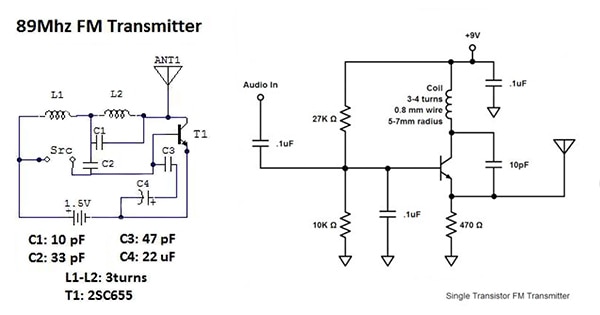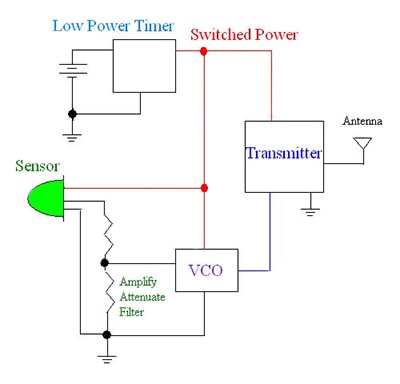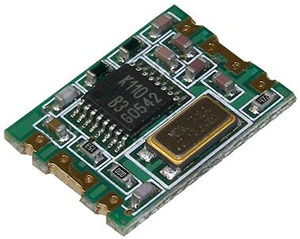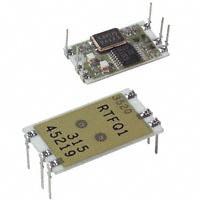Small, Low-Cost, Low-Power Disposable Radios—Part 2: FM, FSK, and PSK
投稿人:电子产品
2015-03-26
In Part 1 of this series on small, low-cost, disposable radio designs we looked at AM technologies, from single-transistor solutions up to integrated SoCs that are well-positioned to provide reliable, one-way communication. Here in Part 2 we examine some low-cost FM solutions as well as Phase Shift Keying (PSK), Frequency Shift Keying (FSK), and simple carrier On/Off Keying (OOK). In the next installment, Part 3, we will examine single-chip radio transceivers that embed a microcontroller alongside the radio to achieve higher levels of performance. All parts, data sheets, tutorials, development kits, and training modules referenced here can be found on the DigiKey website.
On, off with FM
To save power and keep the airways clear, FM radio chips can be used as carrier on, carrier off to transmit data. Like a framed UART packet, the absence of signal is an inactive state and the presence of signal begins a start bit. Thereafter, each bit position is represented by a duration of active carrier or no carrier. This asynchronous technique can work well and can save some energy since a transmitted signal is not needed for off times and logic-zero bits.
Another benefit of FM transmission schemes is that like AM, they can be very small in size and very low cost, especially in single-transistor implementations (Figures 1a and 1b). Discrete components can be in virtually zero-power states fully turned off by a FET until enabled to oscillate. The enable signal can actually be the data line in pure digital On/Off Keying (OOK) mode.

Figures 1a (left) and 1b (right): Many simple single-transistor, low-cost narrow-band FM transmitter designs are readily available in the public domain using standard off-the-shelf parts. Fixed frequencies or tunable versions are both small, low power, and very low cost.
Also note that linear modes can let analog signals control the frequency. This is advantageous in two ways. First, sensor outputs can directly drive the modulating signal like a Voltage Controlled Oscillator (VCO) to provide analog functionality without a microcontroller, A/D converters, and analog components. This is perfect for ultra-small solutions without a micro. Timed transmission intervals can also be controlled, in this case by a very-low frequency oscillator that can turn the unit on and off for a short duration (Figure 2).

Figure 2: Sensors driving VCOs can modulate carriers directly once attenuated or amplified to take advantage of the entire dynamic range. Using a low-power timed FET power switch extends battery life.
The second benefit is that when a microcontroller is present, either it can drive the modulator with an analog signal from a D/A, or simply use two bits with resistive voltage dividers to provide Frequency Shift Keyed (FSK) communications. A single PWM or Phase Shift Keying can also be used and driven by the internals of the micro. Either a wired OR scenario can be used to start up the oscillator, or a third I/O line from the micro can enable the oscillator.
A benefit here is that the transmit frequencies can be very stable and narrow band. This means many units can be in fairly close proximity without interfering with each other and the receiving station merely “tunes in” the channel it wants to monitor. Conversely, several receivers; each tuned to a narrow and specific band could operate concurrently. This allows the receiving stations to use sharp-notch-type filtering to discriminate heavily against noise and interference, improving overall reliability.
More functionality
While single transistor and discrete designs are seemingly the smallest solution, some chips can rival these small sizes while providing added features and functions. Take, for example, the pure FM SoCs from Silicon Labs; the SI4713-B30-GM or the SI4710-B30-GM are good for 76 MHz to 108 MHz bands. While packaged in a 20-pin QFN package, the footprint is only 3 mm x 3 mm and only two external components are needed to implement the entire radio transmitter. Both use digital audio inputs and serial control so a small micro is needed to feed it with data (see the TechZone article “At Your Disposal: Throwaway Micros”).
Other benefits come with a more advanced transmitter solution. First, data can be transmitted in stereo mode. This can either provide two separate channels, or, allows the flexibility to implement a clocked-transmission scheme. Note, these operate in the standard table radio 76 MHz to 108 MHz mode and are limited to 10 microWatts of power, but will work very well for short-range, line-of-sight designs, and interoperable designs.
To save time and test feasibility, modular solutions can be an engineer’s best choice. Instead of spinning your own design and then having to characterize it and certify it, you can simply obtain an OEM module that is fully tested, characterized, and certified (often for international standards).
This is particularly useful for ISM-band FM transmitters since manufacturers are up to date with regard to regional needs and versions for specific countries. Consider, for instance, the RF Solutions QFM-TX1-433 general-purpose FM transmitter module in a very handy 6-pin surface-mountable form-factor (Figure 3).
Figure 3: Modules allow the same form-factor to be programmed for different countries and regions. This lets you make one mother board that can be used in all countries.
It operates at 433 MHz in the unlicensed part of the ISM band, which will allow higher power levels when frequency hopped. This results in longer range line of sight and yet still has good penetrability of walls and objects. Data rates up to 4800 baud are transmittable using CMOS/TTL logic signals from 2.2 to 3.5 V with currents typically 15 mA when active.
The part’s larger 16.8 x 12.5 mm x 2.5 mm dimensions may allow it to mount right on the external antenna to create a sealed and rugged unit. This could be used, for example, to send incremental shaft encoder data for motor positioning remotely on an unmanned vehicle.
A similar, 315 MHz part is the RF Solutions FMRTFQ1-315 (Figure 4). Note here the even lower 7 mA transmitting current and 9600 baud data rates supported. Both RF Solutions parts use digital-data transmissions.

Figure 4: Available from 315 MHz up to 868 MHz, these very stable FM transmitter modules have no adjustable components and can transmit up to 250 meters.
FSK digital modulation
While FM can be continuously variable analog as it is with audio, FSK digital modulation can use highly tuned filters to assure signal integrity. By limiting transmit oscillators to non-interfering frequencies, the optimized filters perform well and discriminate tones.
A fairly high-speed (600 Kbits/sec) data rate part that can operate in FSK as well as GFSK, GMSK, MSK, and OOK modes is the RF Solutions RFM67W-868S2, which can operate in micro-controlled or stand-alone mode.
In stand-alone mode, radio parameters are downloaded and configuration takes place using an external serial EEPROM. This can allow lower cost and smaller size. Using serial interface as an SPI-style peripheral can make it an ideal solution when adding wireless connectivity to an existing wired solution.
New designs also can benefit from the European, American, and Japanese standard configurations and regulatory standards these parts adhere to. What’s more, the high-output power (17 dBm) can simplify amplifier and antenna needs. Bands supported are 315 MHz, 433 MHz, 868 MHz, and 915 MHz.
Next: adding a micro
As we have seen, many solutions will require a micro on board to call the shots. A low-cost disposable radio needs data to transmit. While serial interfacing to transmitters helps keep sizes small, putting the micro on the same die as the transmitter can allow even smaller and more reliable solutions.
In Part 3 of this series we will look at single-chip transmitters that embed a dedicated microcontroller on the same die or within the same package. This can make our disposable radios even more robust, and can add benefits such as higher allowed power levels, frequency hopping and spread spectrum techniques, encryption of data, and synchronized operation.
For more information about the parts discussed in this article, use the links provided to access product pages on the DigiKey website.
免责声明:各个作者和/或论坛参与者在本网站发表的观点、看法和意见不代表 DigiKey 的观点、看法和意见,也不代表 DigiKey 官方政策。






 中国
中国